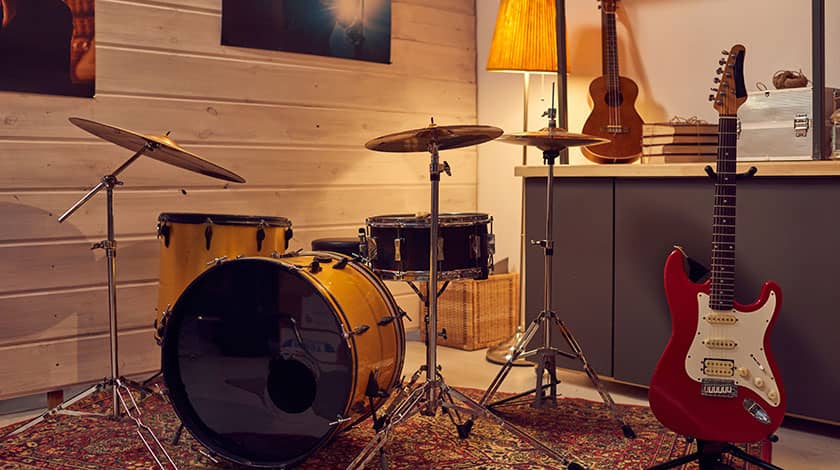How to Pack and Move Musical Instruments Safely

Musical instruments are delicate and often expensive items that require special care and attention when being moved. The slightest mishandling or improper packing can lead to scratches, dents, or even irreparable damage.
Moving with musical instruments to a new place often adds extra degree of stress. Therefore, packing and moving your instruments properly is important to keeping them in good shape and ready to perform when you move. In this blog, we'll provide you with tips and tricks that will help you safely move your musical treasures without breaking the bank.
#1 Preparing for the Move
Preparing and organising your instruments before packing will make the relocation process more effective and less stressful. Here's how to go about it:
A. Categorizing Instruments by Size, Type, and Fragility
Start by sorting your instruments into categories based on their size, type, and fragility. This will help you determine the appropriate packing techniques and materials for each instrument. Consider the following categories:
-
Small and medium-sized instruments – Examples include flutes, violins, and guitars.
-
Large and bulky instruments – Examples include pianos, drum sets, and tubas.
-
Fragile instruments – Instruments that are especially prone to damage, such as string and wind instruments.
-
Sturdy instruments – Instruments that are less susceptible to damage, such as brass and percussion instruments.
B. Creating an Inventory List for Easy Tracking
Make a detailed inventory list of all your musical instruments, including their make, model, and serial number (if applicable). This will not only help you keep track of your belongings during the move but also serve as a valuable reference for insurance purposes. Be sure to take photos of each instrument to document their pre-move condition.
C. Gathering Necessary Packing Materials
Before you start packing your musical instruments, it's essential to gather the right packing materials to ensure their safety during the move. Some essential packing supplies include:
-
Bubble wrap: Provides cushioning and protection for fragile instruments.
-
Packing paper: Useful for wrapping smaller items and filling empty spaces in boxes.
-
Cardboard boxes: Can be found for free or at a low cost from local stores or online marketplaces.
-
Blankets or towels: Can be used to wrap and cushion larger instruments.
-
Packing tape: Necessary for sealing boxes and securing bubble wrap or other materials.
#2 Packing Techniques for Different Instruments
Each type of musical instrument requires specific packing techniques to ensure its safety during the move. The following are the packing methods for string, wind, brass, keyboard, and percussion instruments.
A. String Instruments (guitars, violins, cellos, etc.)
1. Detuning and Disassembling
Before packing your string instruments, follow these steps:
-
Detune: Loosen the strings slightly to reduce tension and prevent damage during the move.
-
Disassemble: Remove any detachable components, such as chin rests, tailpieces, or endpins. Store these parts separately in labeled bags or containers.
2. Padding and Protecting
To protect your string instruments during the move, follow these guidelines:
-
Padding: Wrap the instrument with bubble wrap or soft cloth, paying special attention to the neck, bridge, and headstock.
-
Case protection: Place the wrapped instrument in its hard case or a padded gig bag for extra protection. Fill any empty spaces with packing paper or soft materials to prevent movement.
-
Boxing: If possible, place the cased instrument in a cardboard box with additional padding around it. Seal the box securely with packing tape and label it with the contents and handling instructions.
B. Wind Instruments (flutes, clarinets, saxophones, etc.)
1. Disassembling and Cleaning
Prepare your wind instruments for packing by following these steps:
-
Disassemble: Break down the instrument into its individual parts, if possible.
-
Clean: Wipe down each component with a soft cloth to remove any dirt or moisture.
2. Securely Packing in Cases
Once your wind instruments are disassembled and cleaned, pack them using these guidelines:
-
Padding: Wrap each part in bubble wrap or soft cloth for protection.
-
Case protection: Place the wrapped components in their original cases or a suitable substitute. Fill any empty spaces with packing paper or soft materials to prevent movement.
-
Boxing: If possible, place the cased instrument in a cardboard box with additional padding around it. Seal the box securely with packing tape and label it with the contents and handling instructions.
C. Brass Instruments (trumpets, trombones, tubas, etc.)
1. Cleaning and Disassembling
Prepare your brass instruments for packing by following these steps:
-
Clean: Wipe down the instrument with a soft cloth to remove any dirt or moisture.
-
Disassemble: Remove any detachable components, such as mouthpieces or slides. Store these parts separately in labeled bags or containers.
2. Wrapping and Cushioning
To protect your brass instruments during the move, follow these guidelines:
-
Wrapping: Wrap the instrument with bubble wrap or soft cloth, focusing on any protruding or delicate parts.
-
Case protection: Place the wrapped instrument in its hard case or a padded gig bag for extra protection. Fill any empty spaces with packing paper or soft materials to prevent movement.
-
Boxing: If possible, place the cased instrument in a cardboard box with additional padding around it. Seal the box securely with packing tape and label it with the contents and handling instructions.
D. Keyboards and Pianos
1. Safely Dismantling Components
Prepare your keyboard or piano for packing by following these steps:
-
Disassemble: Remove any detachable components, such as music stands, pedals, or power cords. Store these parts separately in labeled bags or containers.
-
Protect keys: For pianos, lock the keyboard lid, or use a keyboard cover to protect the keys. For electronic keyboards, use a soft cloth or keyboard cover.
2. Properly Wrapping and Securing
To protect your keyboard or piano during the move, follow these guidelines:
-
Wrapping: Wrap the instrument with moving blankets, bubble wrap, or soft cloth, making sure to cover all surfaces and corners.
-
Securing: Use packing tape or stretch wrap to secure the padding in place, being careful not to apply tape directly to the instrument's surface.
-
Boxing (for electronic keyboards): If possible, place the wrapped keyboard in its original box or a suitable cardboard box with additional padding around it. Seal the box securely with packing tape and label it with the contents and handling instructions.
Note: Moving a piano, especially a grand or upright piano, can be challenging due to its size and weight. It's recommended to hire professional piano movers to ensure the safe relocation of your instrument.
E. Percussion Instruments (drums, cymbals, etc.)
1. Disassembling and Protecting Individual Components
Prepare your percussion instruments for packing by following these steps:
-
Disassemble: Break down the drum set into individual components, such as drum shells, cymbals, hardware, and accessories.
-
Protect: Use a soft cloth or packing paper to cover any delicate or protruding parts, such as drum lugs or cymbal stands.
2. Packing Drums and Cymbals Safely
To protect your percussion instruments during the move, follow these guidelines:
-
Padding: Wrap each drum shell and cymbal with bubble wrap or soft cloth for protection.
-
Case protection: Place the wrapped components in their original cases, padded gig bags, or suitable containers. Fill any empty spaces with packing paper or soft materials to prevent movement.
-
Boxing: If possible, place the cased components in a cardboard box with additional padding around them. Seal the box securely with packing tape and label it with the contents and handling instructions.
#3 Loading and Transporting Musical Instruments
Once your instruments are securely packed, it's crucial to load and transport them carefully to ensure their safety during transit. When loading your instruments into the vehicle, follow these tips:
-
Heaviest on the bottom: Place larger, heavier instruments at the bottom and lighter, more delicate instruments on top.
-
Avoid stacking on top of fragile instruments: Do not stack heavy items on top of fragile instruments, such as string or wind instruments.
-
Provide space between instruments: Leave enough space between each instrument to prevent them from rubbing against each other or shifting during transit.
-
Keep instruments upright: Whenever possible, store instruments in their natural playing position to minimize stress on their structure.
How to Secure Instruments to Prevent Damage During Transit
-
Use straps or bungee cords: Secure instruments to the vehicle's interior using straps or bungee cords, being careful not to overtighten or apply pressure on delicate parts.
-
Fill empty spaces with padding: Use blankets, towels, or packing paper to fill any empty spaces between instruments and prevent them from shifting.
-
Check for movement: Before starting your journey, double-check that all instruments are securely in place and unable to move.
#4 Unpacking and Reassembling Your Instruments
Once you've successfully transported your instruments to their new location, it's time to unpack, reassemble, and prepare them for use. When unpacking your musical instruments, follow these steps:
-
Unpack carefully: Remove the packing materials, padding, and cases gently to avoid causing any damage to the instruments.
-
Inspect for damage: Examine each instrument for any signs of damage that may have occurred during transit. If you find any issues, document them with photos and contact your moving company or insurance provider to report the problem.
-
Remove protective materials: Take off any protective covers, such as keyboard covers or padding on delicate parts.
-
Follow the disassembly order in reverse: Reassemble your instruments by reversing the order in which you disassembled them. For example, if you removed the endpin from a cello first, attach it back last.
-
Use the correct tools: If necessary, use the appropriate tools for tightening screws or other hardware, but be careful not to overtighten or damage the instrument.
-
Check for stability: Ensure that all components are securely in place and that the instrument is stable.
Tuning and Adjusting the Instruments for Optimal Performance
Once your instruments are unpacked and reassembled, it's time to tune and adjust them for optimal performance:
-
Tune string instruments: Retune your string instruments, such as guitars, violins, and cellos, using an electronic tuner or tuning fork. Be patient, as it may take some time for the strings to settle and maintain their tuning.
-
Adjust wind and brass instruments: Reassemble and adjust any necessary components, such as mouthpieces or slides, on your wind and brass instruments.
-
Test playability: Play each instrument to ensure it is functioning correctly and producing the desired sound. Make any necessary adjustments to the instrument or its components for optimal performance.
Conclusion
Moving musical instruments safely may seem like a challenging task, but with proper planning and execution, it can be accomplished with ease. By organizing your instruments, gathering the right packing materials, applying specific packing techniques, and using reliable transportation methods, you can ensure a successful move without breaking the bank.
We hope this guide has provided you with valuable insights and tips for packing and moving your musical instruments. Apply these tips to your move, and enjoy the harmony of a successful relocation.











